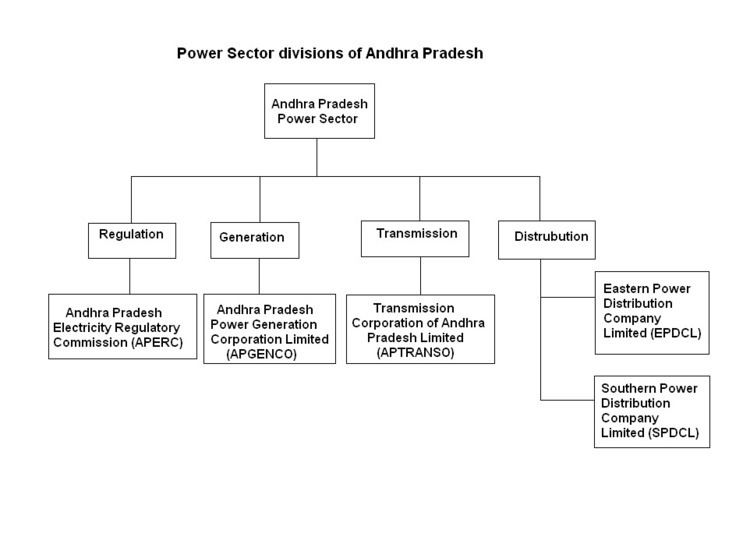 | ||
Power sector of Andhra Pradesh is divided into 4 categories namely Regulation, Generation, Transmission and Distribution. Andhra Pradesh Electricity Regulatory Commission (APERC) is the regulatory body. APGENCO deals with the electricity production and also maintenance, proposes new projects and upgrades existing ones as well. The APGENCO also set up a Special Purpose Vehicle (SPV), named as Andhra Pradesh Power Development Company Limited (APPDCL), a joint venture company of APGENCO (with 50% equity) and IL&FS (50% equity) to set up Krishnapatanam thermal power project (2x800 MW).
Contents
- Thermal power
- Gas fuel based
- Hydroelectric
- Solar
- Windpower
- Other utility power plants
- Transmission system
- References
APTRANSCO is set up for transmission of power. Power distribution in the state is divided into two divisions, namely Eastern Power Distribution Corporation Limited (EPDCL) and Southern Power Distribution Corporation Limited (SPDCL), which distributes the power to the households and the industries. APGENCO, APPDCL, NTPC and other private firms contribute to the generation of power in the state of Andhra Pradesh. Andhra Pradesh has become the second state in India to achieve 100% electrification of all households.
The total installed utility power generation capacity is nearly 21,000 MW in the state. Only 13,688.80 MW is the committed power supply to the state. APtransCo has made long term power purchase agreements for 10,718.31 MW as of 31 January 2016. Rest of the capacity is exporting electricity mainly to Telangana state depending on fuel availability. The per capita electricity consumption is 1003 units with 48,323 million KWh gross electricity supplied in the year 2014–15. The performance of Krishnapatanam thermal power station (2X800 MW) with super critical pressure technology is not satisfactory even after one year commercial operation as the units rarely operate at rated capacity forcing the state to purchase costly power from day ahead trading in IEX.
Thermal power
Thermal power plants are based on the fuel coal, gas, diesel etc. Public sector undertaking NTPC, state level power generating companies and private firms are engaged in this sector for power generation.
Currently operating coal based thermal power plants in Andhra Pradesh are listed below.
Gas fuel-based
The following are the list of presently installed combined cycle gas turbine power plants and diesel engine power plants in the state. However many of these power plants are not operating due to non-availability of natural gas and high cost of liquid fuels.
Hydroelectric
This is the list of major hydroelectric power plants in Andhra Pradesh.
Solar
The state has total installed solar power capacity of 980 MW as of 31 January 2016.
Windpower
The state has total installed wind power capacity of 1866.35 MW as on 19 October 2016.
Other utility power plants
In addition to above projects, there are nearly 89.1 MW small Hydro plants, nearly 421.14 MW bagasse, bio-mass co-generation & bio-mass based projects, nearly 78.79 mini power plants (grid connected) and nearly 67.20 MW other (grid connected) plants based on isolated gas wells, waste heat, industrial waste, municipal waste, etc in private sector. These power plants are not covering captive power capacity in various industries which are not grid connected. In addition, there are innumerable diesel generator sets installed in the state for stand by supply and emergency power supply needs during power outages.
Transmission system
The state has well spread transmission system. APTransCo / DisComs owned and operated transmission lines from 400 kV to 11 kV are 231,127 circuit kilometres excluding the HT lines owned and operated by PGCIL in the state. The spread of high voltage transmission lines (≥ 11 kV) is such that it can form a square matrix of area 1.93 sq km (i.e. on average, at least one HT line within 0.7 km vicinity) in 160,205 sq km total area of the state. DisComs owned and operated LT lines (below 11 kV) are 292,158 circuit kilometres. It represents that there is at least one HT or LT line availability on average within the vicinity of 306 meters in the entire state area. The state has 2905 nos substations (≥ 33 kV) which represents one substation in every 56 sq km area on average (i.e. one substation with in 4 km distance on average). However the maximum peak load met in the year 2014–15 is 6847 MW. Huge installed capacity of the transmission network and the substations is being underutilised with low demand factor.
